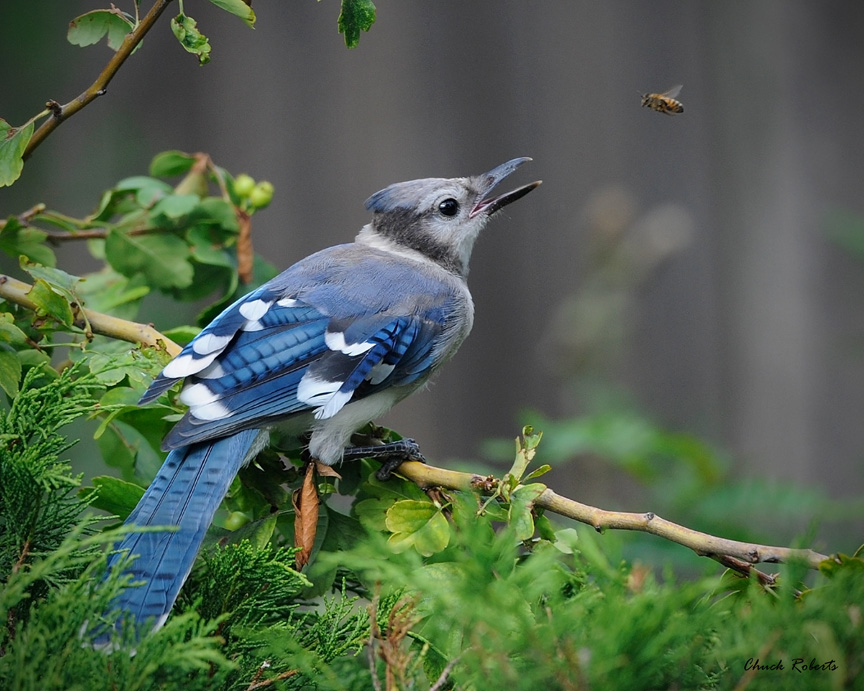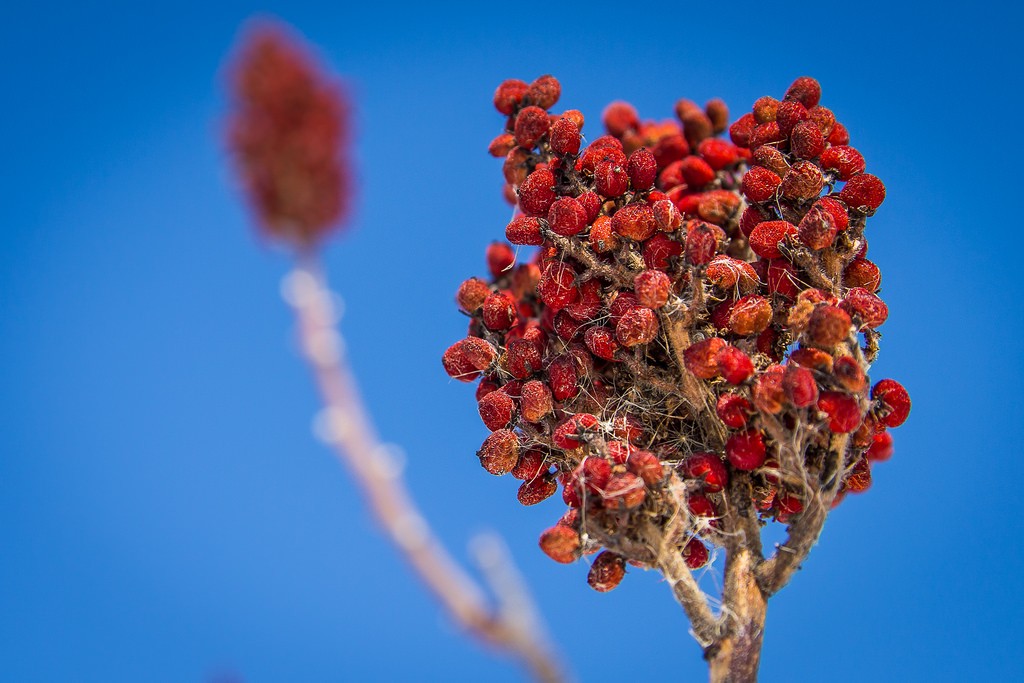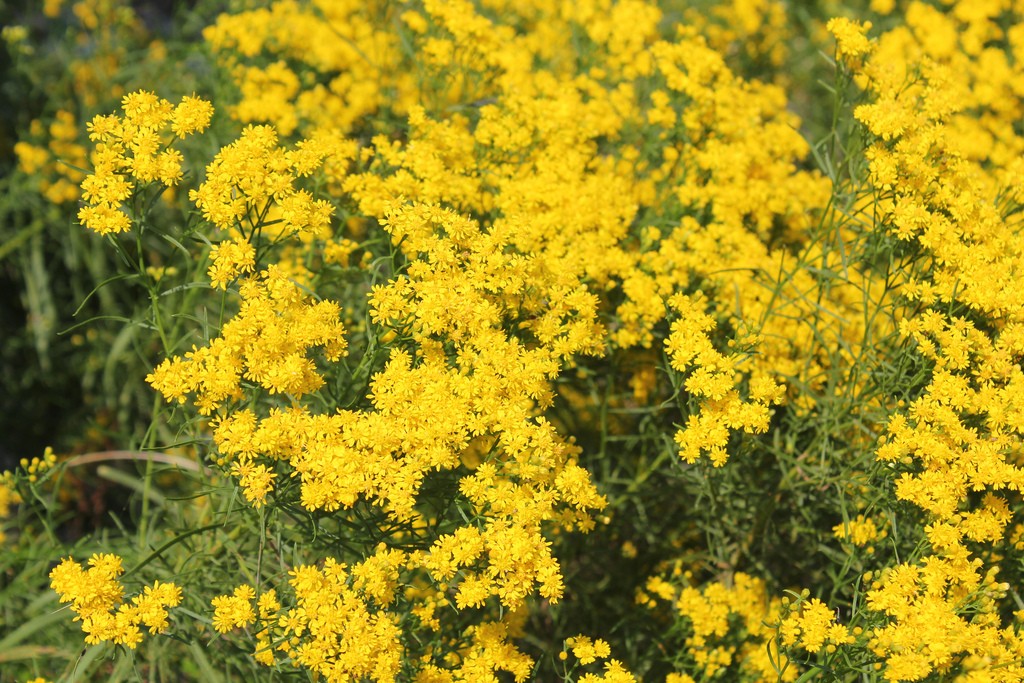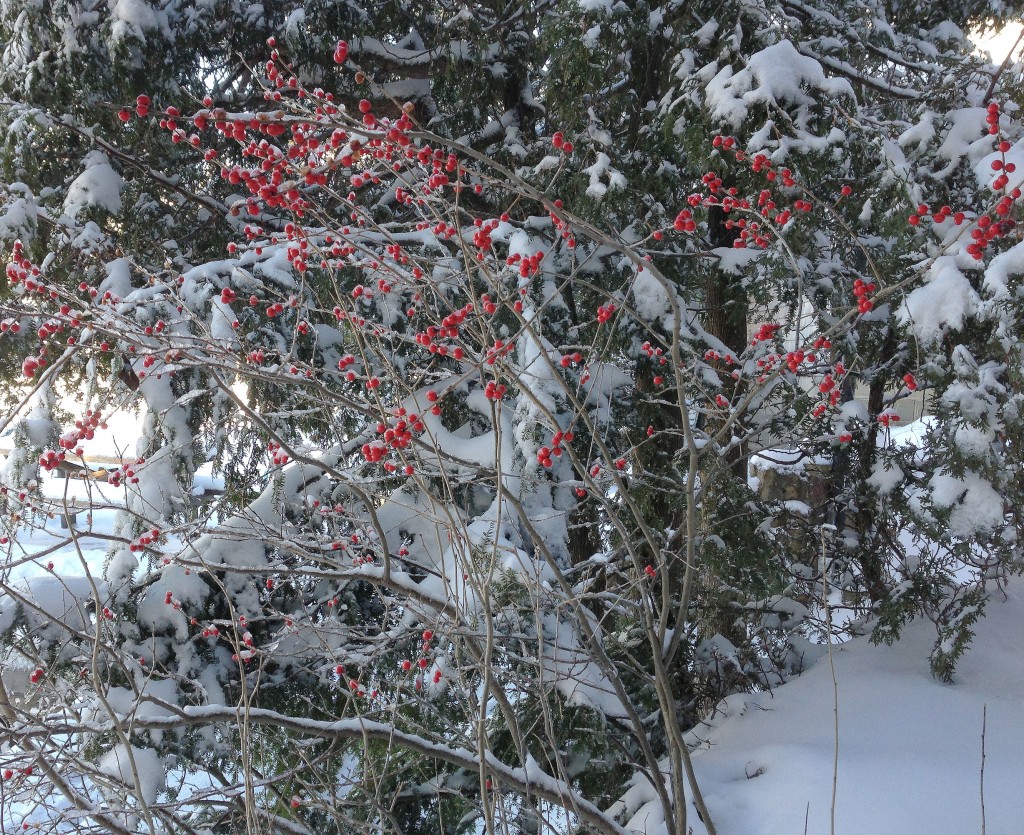The birds and the bees and the backyard
Being a dad taught me that you can only put off addressing delicate but important topics for so long. Eventually you have to step up to the plate, face the music and take the metaphor by the horns. That said, it’s time we had the talk. You know, that talk. About the birds and the bees.

Blue Jay and honeybee. Photo: Chuck Roberts, Creative Commons, some rights reserved
Known for their resilience and in many cases their astonishing physical endurance, birds and bees are also surprisingly fragile. They are both under threat from urban sprawl and other forms of habitat loss, as well as from air pollution, changing weather patterns, agricultural chemicals, and other factors. Fortunately, we can quite easily have a positive influence on the well-being of both, right in our backyards, and it does not involve opening our wallets. Well, not very far.
First, the birds—what do they need? Well, in the case of insectivore species, birds need bees. As in, for lunch. But possibly due to the fact that bees fly around with loaded weapons, the former eat very few of the latter, at least in North America. In the big picture, birds need bees and other pollinators so plants produce tasty fruits and seeds to eat.
More importantly, birds need the spice of life, otherwise known as variety, and this is where we can help. While a few birds are picky eaters, most have highly varied diets. So-called insectivores have been caught eating fruits, and the reverse is true for supposedly vegetarian birds. I’m sure it was all very embarrassing to them the first time those videos were posted.
The point is, all birds will benefit from having fruits, nuts and seeds available at as many times of year as possible. Variety can also mean choosing plants of varying heights and branching habits. This is a great time of year to order nursery stock and flower seeds, and to dream up a plan for bird-scaping your yard, so here are a few suggestions to spice things up for birds.
Since food is least abundant in late winter/ early spring, shrubs like winterberry (Ilex verticillata) or American highbush cranberry (Viburnum trilobum) can be a godsend for returning songbirds. Crabapple (Malus spp.) cultivars having winter-persistent fruits are an attractive way to feed early robins, bluebirds, waxwings, cardinals and finches. The red berries of staghorn sumac (Rhus tyhpinia) are a very important winter/ spring food source for robins, bluebirds, thrushes, catbirds, cardinals, chickadees, turkeys, and woodpeckers.
While pickings get better in summer, you can boost the bird index by planting juneberry (a.k.a. serviceberry, shadbush, etc.) species, for example Amelanchier canadensis (medium-size tree) or A. alnifolia (shrub). These early-blooming plants have stunning fall foliage, and in early summer the fruit attracts robins, waxwings, cardinals, vireos, tanagers, grosbeaks, and hungry children.

Arrowwood fruit remains edible deep into the fall. Photo: Andre Glechikoff, Creative Commons, some rights reserved
Arrowwood (Viburnum dentatum), nannyberry (V. lentago) and wild raisin (V. cassinoides) fruit in mid-summer but retain their sweet, raisin-like berries into fall. The same with shrub dogwood, except the berries aren’t as appetizing to us. Red-osier (Cornus stolonifera), silky (C.amomum), and gray (C. racemosa) dogwoods are easy to grow and usually have good fall color. Robins, bluebirds, thrushes, catbirds, vireos, juncos, cardinals, and warblers will appreciate all these types of shrubs. Elderberry (Sambucus pubescens) and chokecherry (Prunus virginiana) are other landscape-worthy shrubs to consider.
If you make birds happy, you’re already making bees happy, because they like a lot of the same stuff. Technically, bees are the fuzzy ones, while wasps are the guys who shave or wax or whatever, being all smooth and shiny. For our purposes, if it stings like a bee and pollinates like a bee (even ill-tempered yellow jackets are important pollinators), let’s call it one.
Like birds, bees need variety. And messiness. I should clarify that we’re talking about native bees here, not honey bees. With all due respect to those amazing creatures, I don’t think they deserve the rock-star status they seem to enjoy. In “pollinator deserts,” agricultural regions comprising thousands, sometimes tens of thousands, of acres where virtually nothing grows except the desired crop, honey bees are indispensable, no question.
But a multi-year, state-wide Cornell study found that in places with adequate wild pollen and nectar forage—which describes almost every site in the study—honey bees made no difference in pollination rates. According to the U.S. Department of Agriculture (USDA), honey bees are not able to pollinate tomatoes or eggplant, and compared to their wild cousins, do a very poor job on cherries, blueberries, cranberries, squash and pumpkins. This is not to denigrate the honey bee. Of course honey is an important crop, prized for its health-promoting qualities as well as its food value. Plus, honey bees are adorable, and way better dancers than Miley Cyrus.
Drs. Beatriz Moisset of the USDA suggests there are about 4,000 species of native bees in the US, and Cornell indicates New York State may be home to 450 species. In northern NYS, the estimate I’ve heard kicked around is 200 wild bee species. One of the reasons this diversity goes unnoticed is that a lot of species are tiny, and do not fit our image of what a bee should look like.

Sumac is an important nector source for pollinators. Photo: Brett Whaley, Creative Commons, some rights reserved
All plants mentioned above are great for pollinators, juneberry being the first to bloom and elderberry the latest. In addition to being a bird feeder, staghorn sumac is a more significant nectar source than just about any other woody plant. Yet it continues to get bad press because we’ve been taught the dangers of poison ivy, oak and sumac. Poison sumac grows in standing water and has white berries, and maybe one person in ten thousand has seen it. Don’t be afraid to make friends with sumac.
Good news for the insecure—plain is best! When pollen and nectar are in short supply just after snowmelt, comely snow drops and crocuses, while early, are more show than substance, food-wise. Turns out that plain ol’ native soft maple (Acer rubrum) starts to flower while the snow is still receding. The unassuming pussy-willow (Salix discolor) is another abundant source of early-season bee food, plus you can clip twigs in winter and force the rabbit-fur-soft flower buds to open indoors. Most fancy double-petal flower types are so puffed up that bees cannot even get at the pollen. Ordinary “native strain” bee balm, coneflower, columbine and other species have more nectar than their brightly colored, pricey spin-off varieties. Arrogance is bad for bees. Maybe we should start a humility contest.

Goldenrod is another late-season food source. Photo: Azucena Ponce, U.S. Fish & Wildlife Service
Cardinal flower, columbine, bee balm, and butterfly milkweed are nectar-rich flowers adored by bees, and also by hummingbirds, which ought to be listed as honorary bees anyway.
About messiness. Laziness helps birds and bees alike. If we can let some of our place go to seed, literally and figuratively, pollinators will thank us. So-called weeds are what pollinators live on while waiting around for our crops to need pollination. Milkweed, asters, dandelions, Joe-Pye weed, and other things shunned by the snooty are critical for bees. Goldenrod is an essential late-season food source. Bumble bees nest in rock piles, and redpolls and goldfinches want you to leave dried-up coneflowers and black-eyed Susans in the fall so they can pillage the seed heads.
Learn more about birds and bees at birds.cornell.edu, audubon.org, pollinator.org, or xerces.org. Or you could talk to your high-school health class teacher.
Paul Hetzler is a horticulture and natural resources educator with Cornell Cooperative Extension of St. Lawrence County.
Tags: biodiversity, nature, pollinators








